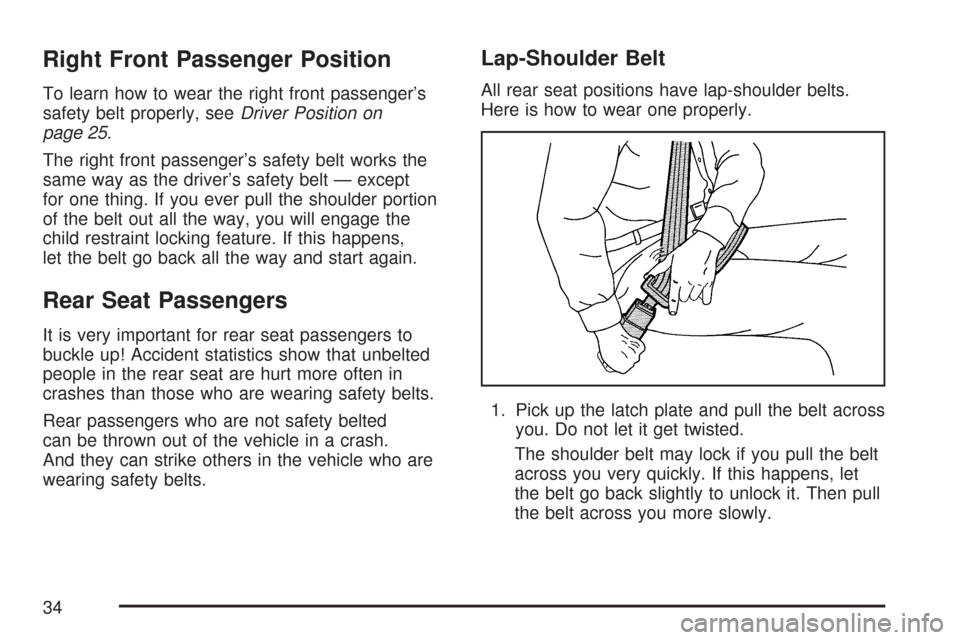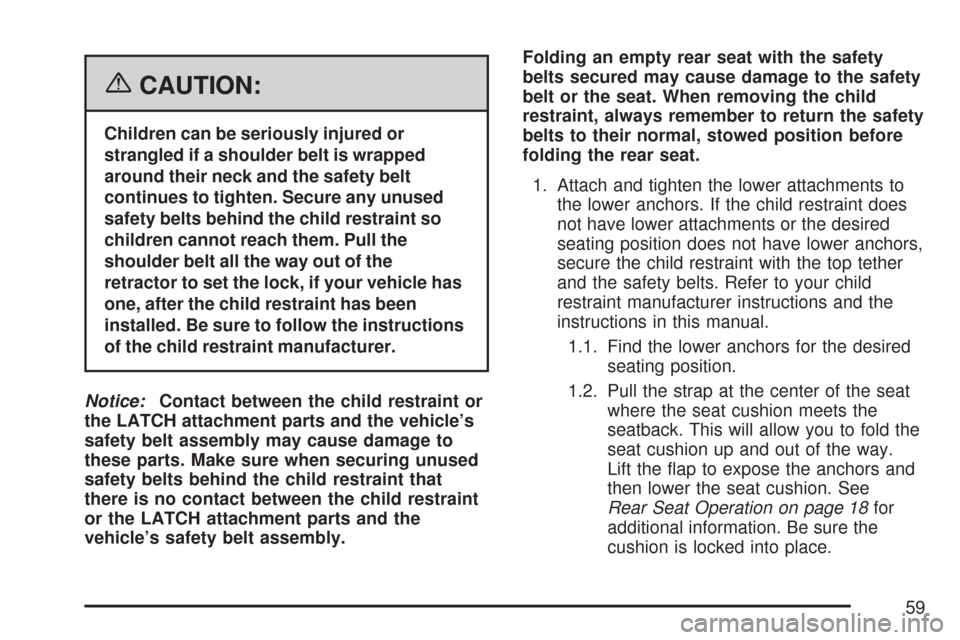Page 27 of 574
The lap part of the belt should be worn low and
snug on the hips, just touching the thighs.
In a crash, this applies force to the strong pelvic
bones. And you would be less likely to slide under
the lap belt. If you slid under it, the belt would
apply force at your abdomen. This could cause
serious or even fatal injuries. The shoulder
belt should go over the shoulder and across the
chest. These parts of the body are best able
to take belt restraining forces.
The safety belt locks if there is a sudden stop
or crash.
27
Page 34 of 574

Right Front Passenger Position
To learn how to wear the right front passenger’s
safety belt properly, seeDriver Position on
page 25.
The right front passenger’s safety belt works the
same way as the driver’s safety belt — except
for one thing. If you ever pull the shoulder portion
of the belt out all the way, you will engage the
child restraint locking feature. If this happens,
let the belt go back all the way and start again.
Rear Seat Passengers
It is very important for rear seat passengers to
buckle up! Accident statistics show that unbelted
people in the rear seat are hurt more often in
crashes than those who are wearing safety belts.
Rear passengers who are not safety belted
can be thrown out of the vehicle in a crash.
And they can strike others in the vehicle who are
wearing safety belts.
Lap-Shoulder Belt
All rear seat positions have lap-shoulder belts.
Here is how to wear one properly.
1. Pick up the latch plate and pull the belt across
you. Do not let it get twisted.
The shoulder belt may lock if you pull the belt
across you very quickly. If this happens, let
the belt go back slightly to unlock it. Then pull
the belt across you more slowly.
34
Page 35 of 574
2. Push the latch plate into the buckle until
it clicks.
Pull up on the latch plate to make sure it
is secure.
When the shoulder belt is pulled out all the
way, it will lock. If it does, let it go back all the
way and start again.
If the belt is not long enough, seeSafety Belt
Extender on page 40.
Make sure the release button on the buckle is
positioned so you would be able to unbuckle
the safety belt quickly if you ever had to.
3. To make the lap part tight, pull up on the
shoulder part.
35
Page 36 of 574
The lap part of the belt should be worn low and
snug on the hips, just touching the thighs. In
a crash, this applies force to the strong pelvic
bones. And you would be less likely to slide under
the lap belt. If you slid under it, the belt would
apply force at your abdomen.This could cause serious or even fatal injuries.
The shoulder belt should go over the shoulder and
across the chest. These parts of the body are
best able to take belt restraining forces.
The safety belt locks if there is a sudden stop or
a crash.
{CAUTION:
You can be seriously hurt if your shoulder
belt is too loose. In a crash, you would
move forward too much, which could
increase injury. The shoulder belt should
�t against your body.
36
Page 56 of 574
Lower Anchor and Top Tether Anchor
Locations
i(Top Tether Anchor):
Seating positions with
top tether anchors.
j(Lower Anchor):
Seating positions with
two lower anchors.To assist you in locating
the lower anchors, each
seating position with
lower anchors has
two labels, near
the crease between the
seatback and the
seat cushion.
The labels are located above a �ap, at the base of
the seatback, in the rear outside seating
positions. The anchors are located under the �ap.
In order to get to the anchors you will need to
pull the strap at the center of the seat where the
seat cushion meets the seatback. This will
allow you to fold the seat cushion up and out of
the way. Lift the �ap to expose the anchors
and then lower the seat cushion. Be sure the
cushion is locked into place.
Second Row
56
Page 59 of 574

{CAUTION:
Children can be seriously injured or
strangled if a shoulder belt is wrapped
around their neck and the safety belt
continues to tighten. Secure any unused
safety belts behind the child restraint so
children cannot reach them. Pull the
shoulder belt all the way out of the
retractor to set the lock, if your vehicle has
one, after the child restraint has been
installed. Be sure to follow the instructions
of the child restraint manufacturer.
Notice:Contact between the child restraint or
the LATCH attachment parts and the vehicle’s
safety belt assembly may cause damage to
these parts. Make sure when securing unused
safety belts behind the child restraint that
there is no contact between the child restraint
or the LATCH attachment parts and the
vehicle’s safety belt assembly.Folding an empty rear seat with the safety
belts secured may cause damage to the safety
belt or the seat. When removing the child
restraint, always remember to return the safety
belts to their normal, stowed position before
folding the rear seat.
1. Attach and tighten the lower attachments to
the lower anchors. If the child restraint does
not have lower attachments or the desired
seating position does not have lower anchors,
secure the child restraint with the top tether
and the safety belts. Refer to your child
restraint manufacturer instructions and the
instructions in this manual.
1.1. Find the lower anchors for the desired
seating position.
1.2. Pull the strap at the center of the seat
where the seat cushion meets the
seatback. This will allow you to fold the
seat cushion up and out of the way.
Lift the �ap to expose the anchors and
then lower the seat cushion. See
Rear Seat Operation on page 18for
additional information. Be sure the
cushion is locked into place.
59
Page 62 of 574
3. Buckle the belt. Make sure the release button
is positioned so you would be able to unbuckle
the safety belt quickly if you ever had to.4. Pull the rest of the shoulder belt all the way
out of the retractor to set the lock.
62
Page 67 of 574
4. Buckle the belt. Make sure the release button
is positioned so you would be able to unbuckle
the safety belt quickly if you ever had to.5. Pull the rest of the shoulder belt all the way
out of the retractor to set the lock.
67